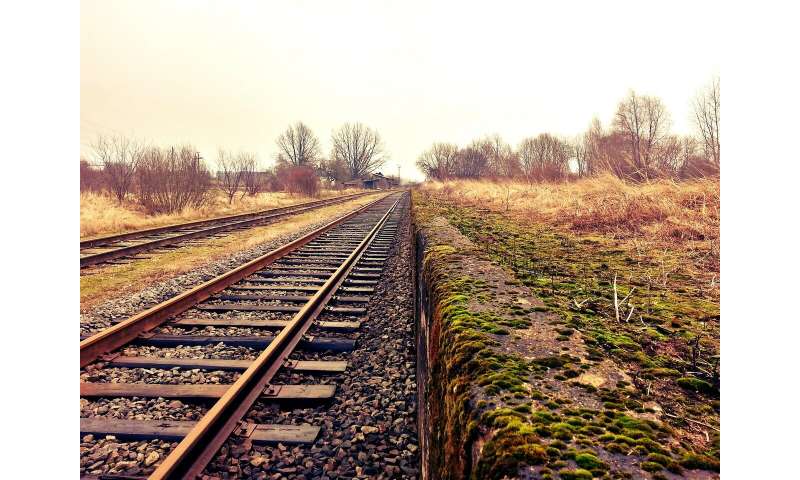#Engineers work out why fallen leaves on train tracks are so slippery
“#Engineers work out why fallen leaves on train tracks are so slippery”

A team of engineers at the University of Sheffield has found an explanation for the extreme slipperiness of train tracks when leaves have fallen on them. In their paper published in Proceedings of the Royal Society A, the group describes testing the interaction of leaves with iron in their lab, and what they learned from it.
Every autumn, travel by train is impaired by leaves falling on the tracks. As the leaves are crushed by a train, a black layer forms on the iron tracks that has been found to be as slippery as an ice skate on ice. Such loss of traction leads to slowed trains, annoyed passengers and freight arriving late to its destination. In this new effort, the researchers sought to better understand the nature of the black layer and why it forms.
To learn more about what happens when leaves fall on train tracks, the researchers attempted to recreate the conditions in their lab. Noting that the leaves only become problematic when it rains, the researchers soaked sycamore leaves in a container of water and left them in the container until the water turned brown. They described the result as an acidic extract. Next, they added a drop of iron chloride to the mix to represent dissolved iron from a railroad track. Doing so darkened the mix. The researchers then applied their mix to pairs of steel surfaces. In addition to adhering to the surfaces, the application led to a sharp loss of friction between the steel surfaces and other objects.
The researchers next removed the tannin from the same kinds of leaves and then repeated the experiment with them—they found that doing so prevented the mixture from turning black and did not lead to slipperiness when applied to steel surfaces. The researchers suggest that it is the tannins in the leaves that adhere to the rails and form the slippery layer. Now that the process is understood, the researchers suggest that it might be possible to develop a chemical application that can break down tannins on rail tracks. They also note that railway managers can manage trees near rail lines in a more eco-friendly manner if they know they only need to remove trees with high tannin content in their leaves.
More information:
Michael Watson et al. The composition and friction-reducing properties of leaf layers, Proceedings of the Royal Society A: Mathematical, Physical and Engineering Sciences (2020). DOI: 10.1098/rspa.2020.0057
© 2020 Science X Network
Engineers work out why fallen leaves on train tracks are so slippery (2020, July 29)
retrieved 29 July 2020
from https://phys.org/news/2020-07-fallen-tracks-slippery.html
This document is subject to copyright. Apart from any fair dealing for the purpose of private study or research, no
part may be reproduced without the written permission. The content is provided for information purposes only.
If you want to read more Like this articles, you can visit our Science category.
if you want to watch Movies or Tv Shows go to Dizi.BuradaBiliyorum.Com for forums sites go to Forum.BuradaBiliyorum.Com



